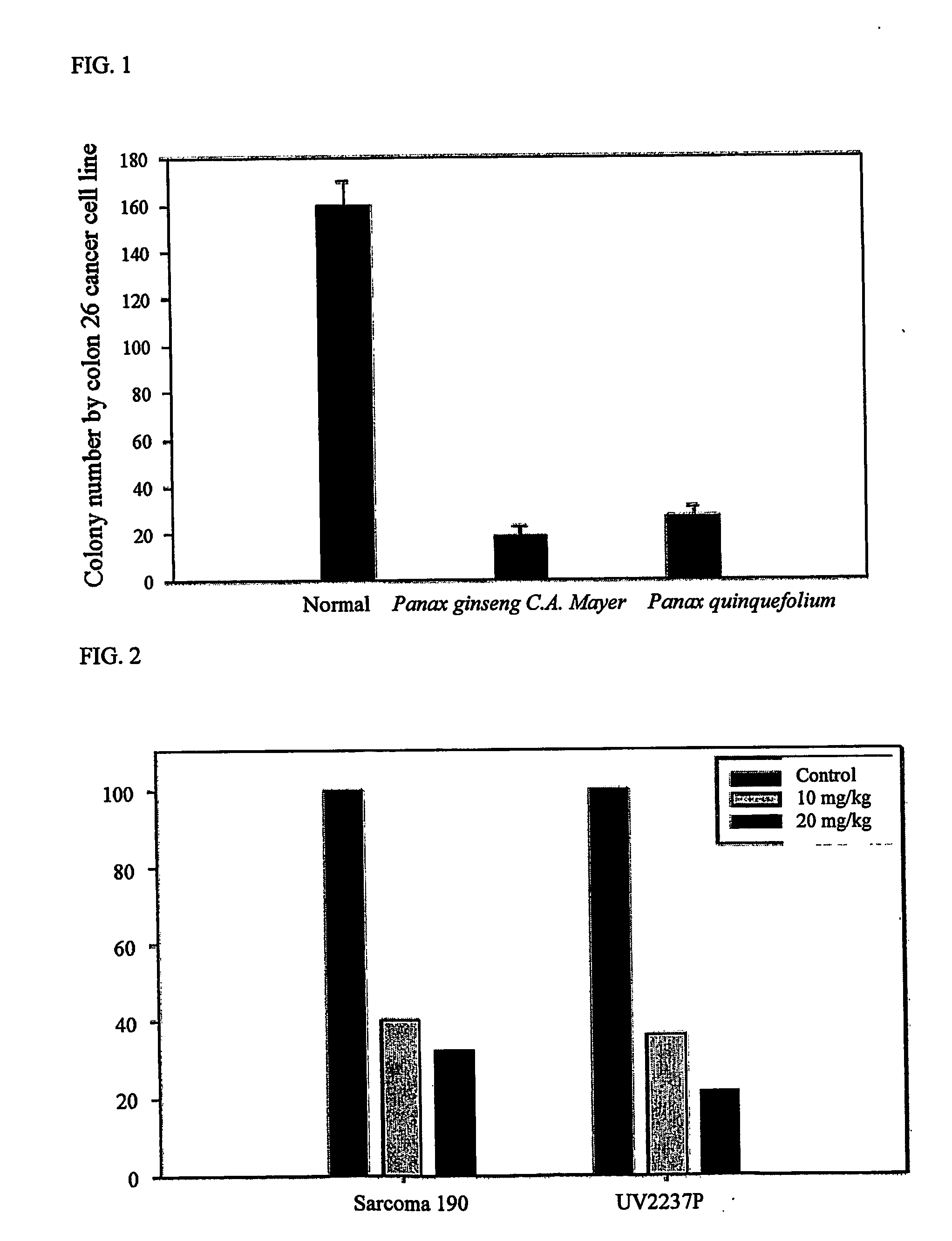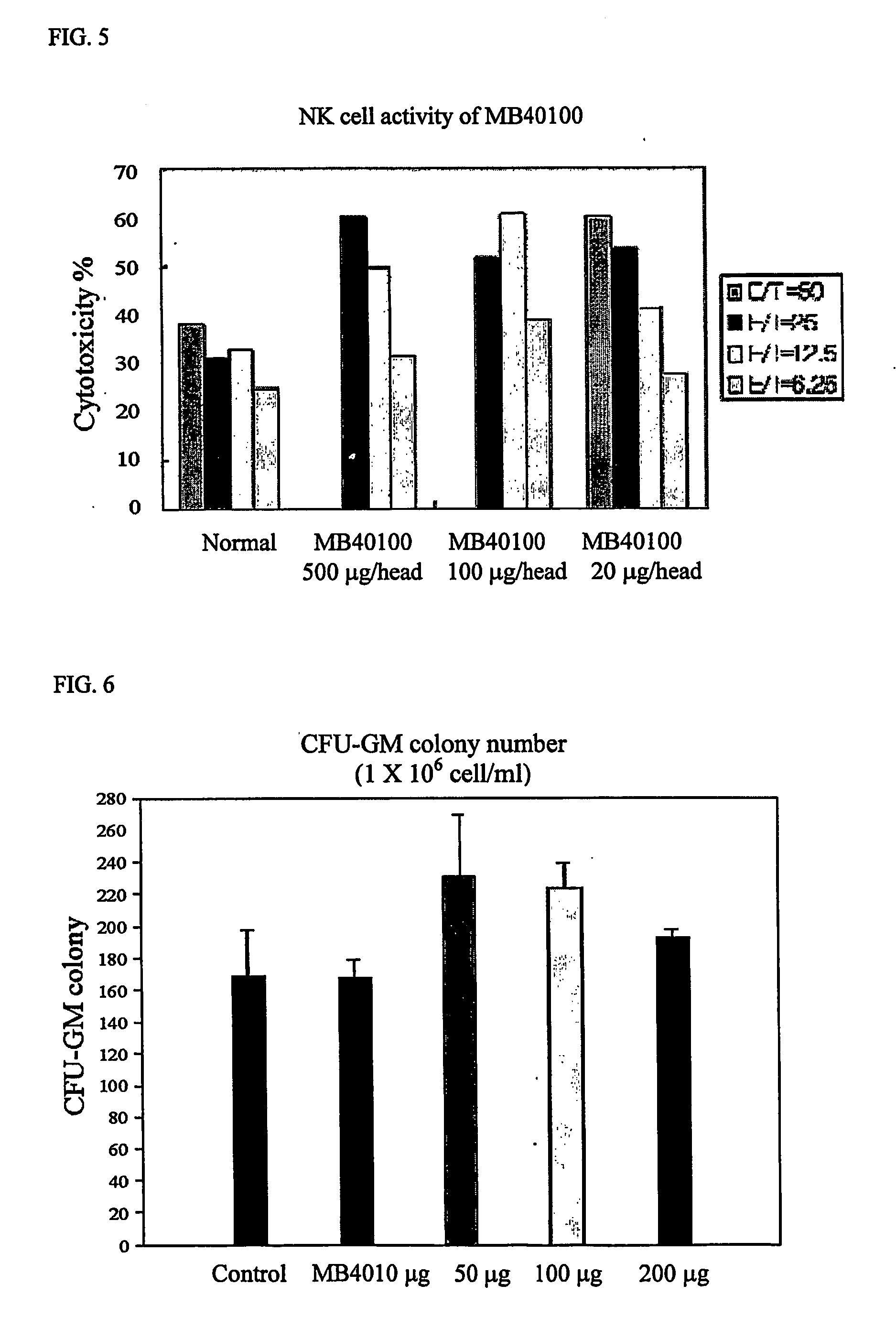Active fraction having anti-cancer and anti-metastasis isolated from leaves and stems of ginseng
a technology of active fraction and ginseng, which is applied in the field of active fraction having cancer and anti-metastasis isolated from leaves and stems of ginseng, can solve the problems of unfavorable anticancer therapy, unfavorable anticancer therapy, and unfavorable antibacterial therapy, and achieves significant inhibition of colon 26-m3.1 lung metastasis, tumor reduction, and tumor reduction
- Summary
- Abstract
- Description
- Claims
- Application Information
AI Technical Summary
Benefits of technology
Problems solved by technology
Method used
Image
Examples
preparation example 1
Preparation of a Crude Polysaccharide Extract from the Leaves and / or Stems of Ginseng
[0051] 100 g of the Panax ginseng C. A. Mayer leaves and / or stems was added into 1 L of water and then heated at 100° C. for 5 hours in order to extract active ingredients therefrom. The liquid phase was separated from the leaves and / or stems by filtration and centrifuged at 7,000 rpm for 30 minutes to remove insoluble impurities therefrom. The supernatant, containing polysaccharides, was concentrated to 20 brix at 70° C. under 760 mmHg, to obtain 100 ml of the concentrated solution. Sodium chloride was added to a final concentration of 1 M, and 300 ml of ethanol was then added. The resulting mixture was left for 1 hour to allow precipitation. The precipitate was washed two times with 100 ml of 95% ethanol to remove impurities and then dialyzed, followed by freeze-drying, to obtain a crude polysaccharide extract.
[0052] The above process was also repeated for the leaves and / or stems of Panax quinqu...
preparation example 2
Preparation of Polysaccharides from the Leaves and / or Stems of Ginseng
[0053] 500 g of Panax ginseng C. A. Mayer was added into 5 L of distilled water and heated for 3 hours to prepare an extract solution. Slurry was separated from the extract solution by gauze. The extract solution was centrifuged at 7,000 rpm for 20 minutes to separate a supernatant. The supernatant was adjusted to about pH 8.0 and 0.4 M NaCl10 mM Tris-HCl and then loaded in an anion exchange resin column (PA312-based strong basic anion exchange resin, Samyang Corporation) at the rate of 30 m / min. The anion exchange resin had been previously equilibrated with 0.4 M NaCl / 10 mM Tris-HCl so as to adsorb only impurities and prevent polysaccharides from being adsorbed. The anion exchange resin was sufficiently washed with a buffer, and the solution, having passed through the resin, was adjusted to about pH 6-7. The resulting solution was loaded in an adsorbent resin (HP 20, Mitsubishi Corporation) at the rate of 30-50 ...
preparation example 3
Preparation of MB40100, an Extract from the Leaves and / or Stems of Ginseng, and Preparation of a Liquid Solution for Injection
[0055] The solution that had been loaded in the anion exchange resin column (Q-sepharose) in PREPARATION EXAMPLE 2, originated from Panax ginseng C. A. Mayer, was loaded in a column filled with silica gels to remove pyrogen materials therefrom. 3 volumes of ethanol was added to precipitate polysaccharides, and the polysaccharides were collected by centrifugation and then washed two times with 95% ethanol to remove impurities. The resulting segment was dissolved in triple distilled water and then dialyzed against a molecular weight cut off of less than 6,000 to remove the remaining ethanol. For sterility, the resulting fraction was loaded in a 0.2 μm filtering system to prepare a solution without pyrogen materials. The aseptic solution was freeze-dried in a 3 ml vial to prepare a polysaccharide fraction. The dried polysaccharide fraction was dissolved in sali...
PUM
| Property | Measurement | Unit |
|---|---|---|
| Temperature | aaaaa | aaaaa |
| Fraction | aaaaa | aaaaa |
| Fraction | aaaaa | aaaaa |
Abstract
Description
Claims
Application Information
 Login to View More
Login to View More - R&D
- Intellectual Property
- Life Sciences
- Materials
- Tech Scout
- Unparalleled Data Quality
- Higher Quality Content
- 60% Fewer Hallucinations
Browse by: Latest US Patents, China's latest patents, Technical Efficacy Thesaurus, Application Domain, Technology Topic, Popular Technical Reports.
© 2025 PatSnap. All rights reserved.Legal|Privacy policy|Modern Slavery Act Transparency Statement|Sitemap|About US| Contact US: help@patsnap.com



